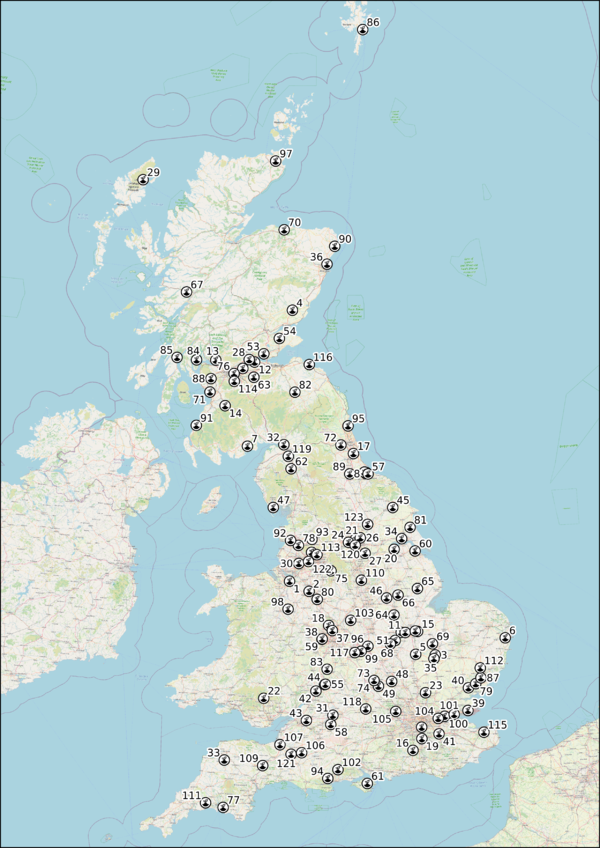Non-Hazardous Landfill: Difference between revisions
No edit summary |
Tag: Rollback |
||
| Line 78: | Line 78: | ||
==Operational Landfill== | ==Operational Landfill== | ||
{{#clear_external_data:}} | |||
{{#get_db_data: db=engy |from=nhlandfill |data=site=site,id=id,operator=operator}} | |||
[[File:Landlfill_map.png|600px|right]] | |||
{|Class="wikitable sortable" | |||
! ID !! Site Name !! Operator | |||
{{#for_external_table:<nowiki/> | |||
{{!}}- | |||
{{!}} {{{id}}}. | |||
{{!}} [[{{{site}}}]] | |||
{{!}} [[{{{operator}}}]] | |||
}} | |||
|} | |||
<br clear="all" /> | |||
==References== | ==References== | ||
<references /> | <references /> | ||
Revision as of 12:18, 5 April 2022
Only a Non-Hazardous Landfill can accept Non-Hazardous Waste which includes Municipal Solid Waste (MSW) and any other Non-Hazardous Waste of a similar nature that meets the relevant Waste Acceptance Criteria. They can also accept Inert Waste and Stabilised Non-Reactive Hazardous Waste (SNRHW), for example those vitrified or solidified[1].
Capacity Non-Hazardous Landfill
The capacity of Non-Hazardous Landfill is reported[2] by the EA for England and is summarised in the graph and table below, but it excludes that capacity of Non-Hazardous Landfill with a Stabilised Non-Reactive Hazardous Waste cell (which comprised 89.4 million cubic metres in 2015 dropping to 69.4 million cubic metres in 2019 and 67 million cubic metres in 2020 - which is summarised on the Hazardous Landfill page). Note that Non-Hazardous Landfill also provides Landfill capacity for Inert Waste in the sense that these waste are used for daily cover and site engineering purposes.
The number of sites in 2020 in England was 113, a drop from 118 in 2019, whilst capacity increased between the two years.
| <graph>{
"width":400, "height":200, "data":[{ "name":"table", "values":[ {"x":2015,"y":230.3},{"x":2016,"y":211.9},{"x":2017,"y":194.4}, {"x":2018,"y":185.2},{"x":2019,"y":160.2},{"x":2020,"y":164.8} ] }], "scales": [ {
"name": "x",
"type": "linear",
"range": "width",
"zero": false,
"domain": {"data": "table", "field": "x"}
},
{
"name": "y",
"type": "linear",
"range": "height",
"nice": true,
"domain": {"data": "table", "field": "y"}
}
], "axes": [ {"type": "x", "scale": "x", "format":"d","title":"Year"},
{"type": "y", "scale": "y", "grid":true, "title":"Million Cubic Metres"}
], "marks": [ {
"type": "line",
"from": {"data": "table"},
"properties": {
"enter": {
"x": {"scale": "x", "field": "x"},
"y": {"scale": "y", "field": "y"},
"stroke": {"value": "steelblue"},
"strokeWidth":{"value":2}
}
}
},
{ "type": "symbol",
"from": {"data": "table"},
"properties": {
"enter": {
"x": {"scale":"x","field": "x"},
"y": {"scale":"y","field": "y"},
"fill": {"value": "steelblue"},
"size":{"value":15}
}
}
} ] }</graph> |
| Year | 2015 | 2016 | 2017 | 2018 | 2019 | 2020 |
| Million Cubic Metres | 230.3 | 211.9 | 194.4 | 185.2 | 160.2 | 164.8 |
Operational Landfill

